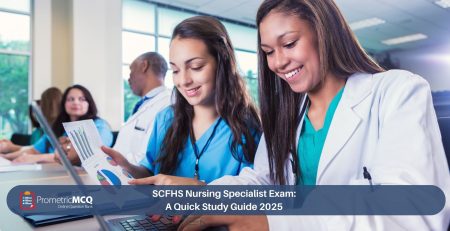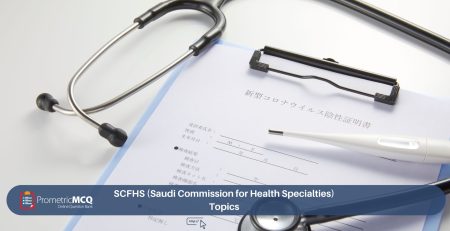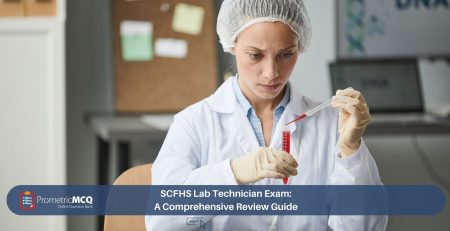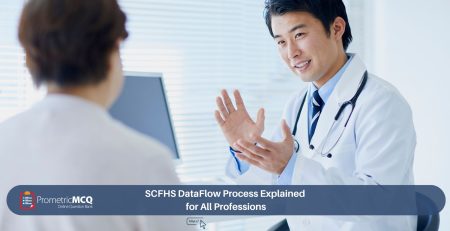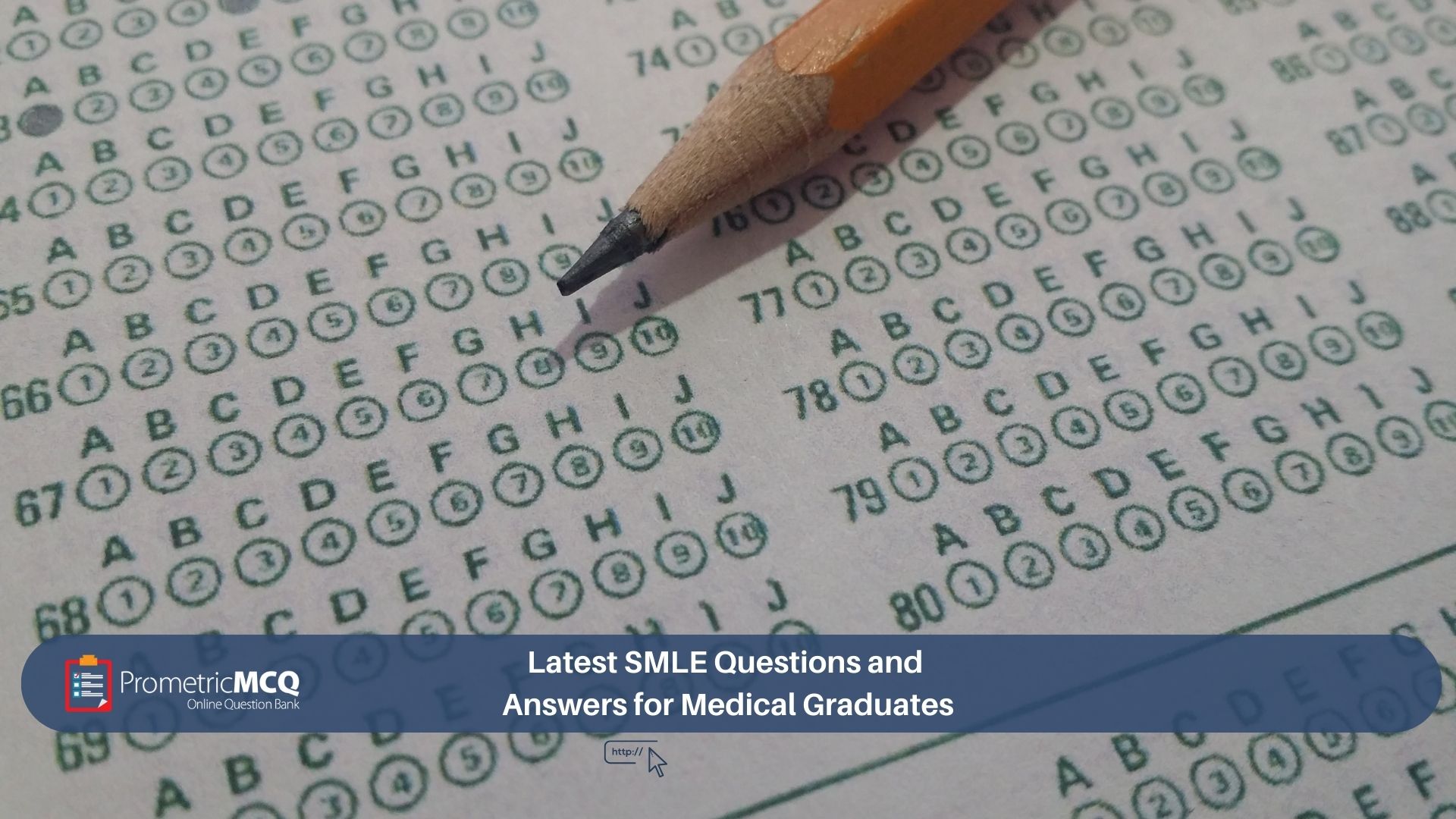
Latest SMLE Questions and Answers for Medical Graduates
fatima@prometricmcq.com2025-09-17T21:24:08+00:00Table of Contents
ToggleLatest SMLE Questions and Answers for Medical Graduates (2025)
For medical graduates setting their sights on a career in the Kingdom of Saudi Arabia, the Saudi Medical Licensing Exam (SMLE) represents the final, formidable hurdle. Administered by the Saudi Commission for Health Specialties (SCFHS), this six-hour, 300-question marathon is the ultimate test of clinical competency for any general physician wishing to practice. More than a test of textbook recall, the SMLE is a rigorous evaluation of your diagnostic reasoning, your ability to formulate management plans, and your grasp of patient safety principles in a high-pressure, simulated environment.
The key to conquering this exam lies in understanding its language: the Multiple-Choice Question (MCQ). The most effective preparation involves moving beyond passive studying and engaging directly with the latest, high-yield questions that mirror the true format and difficulty of the exam. By dissecting these case-based questions and their detailed rationales, you train your mind to navigate complex clinical scenarios, identify subtle clues, and select the single best course of action from a list of plausible options.
This ultimate 2025 guide is designed to be your most valuable resource in this endeavor. We have compiled a set of the latest, high-yield SMLE sample questions, complete with in-depth, expert-written answers. This guide will not only show you *what* to study but *how* to think. We’ll explore the exam’s core domains, provide a strategic framework for your preparation, and address your most pressing concerns in a comprehensive FAQ. This is your first step towards mastering the Saudi Medical Licensure Examination (SMLE).
Key Takeaways for SMLE Success
- It’s a Clinical Reasoning Exam: The SMLE tests your ability to think like a doctor on a busy ward, not a student in a lecture hall. Focus on diagnosis, investigation, and management.
- Master the “Big Four”: Internal Medicine, Pediatrics, OB/GYN, and Surgery make up the vast majority of the exam. Your success depends on your strength in these areas.
- Practice is Paramount: The single most effective study method is consistent practice with a high-quality, up-to-date question bank.
- Time Management is a Skill: With only 1.2 minutes per question, you must develop a rhythm. Practice with timed blocks to build both speed and accuracy.
- Read Every Rationale: The learning is in the explanation. Understand not only why the correct answer is right, but why every incorrect option (distractor) is wrong.
SMLE High-Yield Domains: Where to Focus Your Practice
A successful study plan allocates time intelligently, focusing on the most heavily tested areas. The SMLE blueprint is comprehensive, but a clear pattern of emphasis emerges.
| Core Domain | Approx. Weightage | High-Yield Topics for MCQ Practice |
|---|---|---|
| Internal Medicine | ~30% | Cardiology (ACS, Heart Failure, HTN), Endocrinology (Diabetes, DKA, Thyroid), Pulmonology (Asthma, COPD, PE), Gastroenterology (PUD, IBD), and Infectious Diseases. |
| Pediatrics | ~25% | Growth & Development milestones, common infectious diseases (croup, bronchiolitis), vaccination schedules, and pediatric emergencies (febrile seizures, dehydration). |
| Obstetrics & Gynecology | ~20% | Antenatal care, normal and abnormal labor, obstetric emergencies (postpartum hemorrhage, eclampsia), and common gynecological issues (PCOS, abnormal uterine bleeding). |
| General Surgery | ~15% | Management of the “acute abdomen” (appendicitis, cholecystitis, pancreatitis), trauma assessment (ATLS principles), and pre-operative/post-operative care. |
| Other Specialties | ~10% | Includes high-yield topics from Family Medicine, Psychiatry (depression, anxiety), Ethics, and Biostatistics (interpreting studies). |
When faced with a complex case, simplify it. What is the patient’s main problem? What is the most likely diagnosis? What is the single most important next step to confirm the diagnosis or stabilize the patient?
Latest SMLE Sample Questions & In-Depth Answers
Engage with these questions as if you were in the exam hall. Read the stem carefully, formulate your answer, and then compare your reasoning with our detailed rationales. This active process is the key to deep learning. For a larger set of questions, a dedicated General Practitioner exam MCQ bank is essential.
Question 1: Internal Medicine (Cardiology)
A 65-year-old man with a history of hypertension and type 2 diabetes presents to the emergency department with a 2-hour history of severe, crushing substernal chest pain radiating to his left arm. An ECG shows ST-segment elevation in leads II, III, and aVF. Which of the following is the most likely diagnosis?
- Pericarditis
- Anterior wall ST-elevation myocardial infarction (STEMI)
- Inferior wall ST-elevation myocardial infarction (STEMI)
- Pulmonary embolism
Correct Answer: C
Rationale: This is a classic presentation of an acute coronary syndrome. The key to answering this question is ECG interpretation. ST-segment elevation in leads II, III, and aVF specifically localizes the infarction to the inferior wall of the left ventricle. This territory is supplied by the right coronary artery (in most individuals). The clinical presentation of crushing chest pain in a patient with risk factors strongly supports the diagnosis of an MI.
Why other options are incorrect:
A: Pericarditis typically presents with pleuritic chest pain that is relieved by sitting forward and diffuse, concave ST elevation across most leads, not localized to a specific coronary territory.
B: An anterior wall STEMI would show ST elevation in the precordial leads, specifically V1-V4, which are supplied by the left anterior descending (LAD) artery.
D: A massive pulmonary embolism can cause chest pain and even ST changes, but it would not typically produce this specific pattern of localized ST elevation. It is more likely to cause tachycardia and signs of right heart strain (like T-wave inversions in V1-V3).
Question 2: Pediatrics
A 2-year-old child is brought to the clinic with a 3-day history of a low-grade fever, barking cough, and noisy breathing that is worse at night. On examination, the child has inspiratory stridor when agitated. What is the most likely causative agent?
- Respiratory Syncytial Virus (RSV)
- Streptococcus pneumoniae
- Haemophilus influenzae type b
- Parainfluenza virus
Correct Answer: D
Rationale: The clinical triad of a barking cough, inspiratory stridor, and hoarseness is the hallmark of laryngotracheobronchitis, commonly known as croup. Parainfluenza virus is the most common etiological agent responsible for croup, causing inflammation of the larynx and subglottic airway.
Why other options are incorrect:
A: RSV is the most common cause of bronchiolitis, which presents with wheezing and respiratory distress in infants, not the characteristic barking cough of croup.
B: Streptococcus pneumoniae is a common cause of bacterial pneumonia and otitis media.
C: Haemophilus influenzae type b was a classic cause of epiglottitis, a life-threatening emergency that presents with drooling, dysphagia, and distress (the “3 D’s”). Thanks to widespread vaccination, it is now rare.
Question 3: Obstetrics & Gynecology
A 28-year-old woman at 34 weeks of gestation presents with a sudden onset of painless, bright red vaginal bleeding. Her abdomen is soft and non-tender on palpation, and the fetal heart rate is reassuring. What is the most likely diagnosis?
- Placenta previa
- Placental abruption
- Vasa previa
- Cervical ectropion
Correct Answer: A
Rationale: The classic presentation of placenta previa is painless, bright red vaginal bleeding in the third trimester. The bleeding occurs because the placenta is implanted in the lower uterine segment, over or near the cervical os, and begins to detach as the cervix starts to efface and dilate. The absence of abdominal pain and a non-tender uterus are key features that distinguish it from placental abruption.
Why other options are incorrect:
B: Placental abruption (premature separation of the placenta) typically presents with painful vaginal bleeding (often dark red), a firm or rigid uterus (hypertonic), and signs of fetal distress.
C: Vasa previa is a rare but catastrophic condition where fetal blood vessels run across the cervical os. It typically presents with vaginal bleeding and acute fetal distress immediately upon rupture of membranes.
D: Cervical ectropion can cause light bleeding or spotting, especially post-coital, but it does not cause the significant, sudden bleeding described in this case.
Question 4: Surgery
A 22-year-old man presents with a 24-hour history of periumbilical pain that has now migrated to the right lower quadrant. He reports anorexia, nausea, and low-grade fever. On examination, there is tenderness to palpation at McBurney’s point. What is the most appropriate next step in management?
- Administer broad-spectrum antibiotics and observe
- Perform an abdominal ultrasound or CT scan
- Schedule an emergency exploratory laparotomy
- Discharge home with analgesics and instructions to return if symptoms worsen
Correct Answer: B
Rationale: This patient has a classic presentation for acute appendicitis, with a high Alvarado score (migratory pain, anorexia, nausea, tenderness in RLQ, rebound tenderness, fever). While the clinical suspicion is high, the standard of care in modern medicine, especially in a young male where other diagnoses are possible, is to confirm the diagnosis with imaging before proceeding to surgery. An abdominal ultrasound is often the first choice, especially in children and thin adults, while a CT scan has higher sensitivity and specificity and is frequently used to definitively confirm appendicitis and rule out other pathologies.
Why other options are incorrect:
A: Administering antibiotics without a confirmed diagnosis can mask the symptoms and delay necessary surgical intervention, increasing the risk of perforation.
C: While an appendectomy is the likely treatment, proceeding directly to surgery without imaging confirmation is generally reserved for cases where the diagnosis is unequivocal or the patient is unstable. Imaging helps reduce the rate of negative appendectomies.
D: Discharging the patient is unsafe, as it risks progression to appendiceal rupture, peritonitis, and sepsis.
Frequently Asked Questions (FAQs) for the SMLE
While a comprehensive review book is useful for reference, the single most effective tool is a high-quality, up-to-date question bank (QBank) specifically designed for the SMLE. A good QBank, like those offered at PrometricMCQ, provides thousands of case-based questions and detailed rationales that train your clinical reasoning skills.
The SMLE has a similar clinical focus to the USMLE Step 2 CK and PLAB Part 1. However, it may have a stronger emphasis on common presentations in the region and follows clinical guidelines that are internationally recognized but applied within the Saudi healthcare context. Unlike USMLE Step 1, it has a much lighter focus on basic sciences.
The exam is scored out of 800, with the official passing score set at 500 (~62.5%). The score is scaled to ensure fairness across different exam versions. To be safe, your goal should be to consistently score above 70-75% on your practice tests.
These topics constitute a smaller but significant portion of the exam. You can expect around 5-10% of questions to cover these areas. Mastering the basics of study design, sensitivity/specificity, and ethical principles like confidentiality and informed consent can provide you with relatively easy marks. Authoritative sources like the World Health Organization (WHO) section on ethics can be a good reference.
A simple on-screen calculator is provided within the Prometric testing software for any questions that may require calculations (e.g., fluid management, biostatistics). You are not allowed to bring your own calculator.
The SMLE is a marathon. It’s broken into two 3-hour blocks of 150 questions each, with an optional break in between. It is highly recommended that you take the break to rest, eat a light snack, and clear your head. During your preparation, you must take full-length mock exams to build the mental and physical stamina required to maintain focus for the entire duration.
For an average medical graduate, a dedicated study period of 4-6 months is ideal. This allows enough time to thoroughly review all major specialties and complete a large question bank at least once. Consistency is key; 3-4 hours of focused study every day is more effective than cramming on weekends.
Before you can sit for the exam, you must complete the registration and credential verification process. This involves creating a profile on the SCFHS Mumaris Plus portal and completing the Primary Source Verification (PSV) with DataFlow. This process can take several weeks, so it is essential to start early. For a detailed guide, see our article on how to register for the SCFHS exam.
Passing the SMLE makes you eligible to be licensed as a General Practitioner in Saudi Arabia. It is also the primary requirement for applying to residency (specialty training) programs within the Kingdom. After passing, you will complete your registration on Mumaris Plus to receive your professional SCFHS license.
A hybrid approach is best. In the initial phase of your preparation (first 2-3 months), study system-wise (e.g., Cardiology, then Pulmonology) to build a strong foundation. In the final phase (last 1-2 months), switch exclusively to random, timed blocks of questions. This simulates the actual exam and improves your ability to rapidly switch between different clinical topics.
Conclusion: Your Gateway to a Medical Career in KSA
The Saudi Medical Licensing Exam is a demanding but fair assessment of the skills required to be a competent physician. Success is not a matter of luck; it is the direct result of a strategic, disciplined, and practice-oriented preparation plan. By focusing on high-yield topics, mastering the art of MCQ deconstruction, and building your clinical stamina, you can confidently meet and exceed the passing standard. Use this guide and these sample questions as your launchpad, commit to the process, and you will be well on your way to earning your license and embarking on a rewarding medical career in Saudi Arabia.
Ready to Test Your Knowledge Against the Latest Questions?
Our SMLE QBank is meticulously curated with thousands of the latest high-yield questions, expert-level rationales, and performance analytics to pinpoint your weaknesses. It's the ultimate tool to prepare you for exam day.


